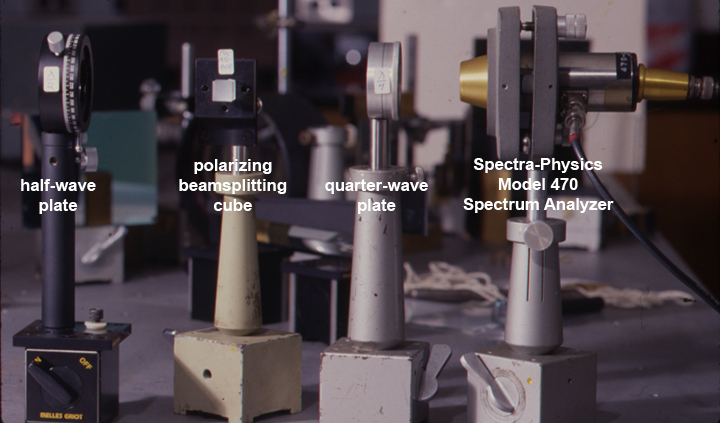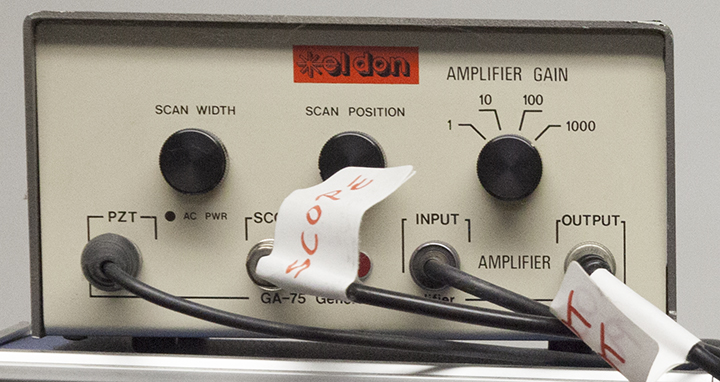
Charles Fabry and Alber Perot developed this type of interferometer in 1899. A pair of parallel semi-reflecting glass plates form an optical cavity, and the distance between them can be varied, and light can either pass through them, or not, its energy nulled by destructive interference when the reflecting surfaces are a whole number plus a 1/ 2 wavelength apart.
At the Home + Studio we have a Spectra-Physics 470 head, driven by a Jodon/Eldon box, wired up to a Kikusui Oscilloscope. The driver sends a sine wave of current into the head's piezo-electric donut, to which one of the mirrors of the resonating cavity is attached. As the volage sweeps through its range, the cavity expands and contracts, causing constructive or destructive interference depending on how the resonator is spaced. If the spacing is a multiple of the laser's lambda, then a bright flash is focused on the interferometer's photodetector, which tranlates to a blip on the oscilloscope. On the right of this image, the scope traces are shown, the bottom one being a single longitudinal mode. The left shows what effect the multiple modes have on the coherence length in a hologram.




Here is he device in action. Before the beam enters the head, it passes through a half-wave plate, followed by a polarizing beamsplitting cube, the basic polarizing beamsplitting configuration. This arrangement is sometimes necessary to put in place to attenuate the beam before it enters the Spectrum Analyzer, so as not to overload the detector. After the beamsplitting cube a quarter wave plate was introduced, to circularly polarize the beam as part of an optical isolation circuit. Any beams going back into the laser cavity could cause feedback that would spoil the spectral analysis.

The analyzer head had been bought by International Holographics in the late '60's or early '70's. They ran the scan from the sawtooth sweep output of an ancient Tektronics Oscilloscope, a feature lacking in contemporary scipes. In the late '80's an Eldon GA-75 Generator Amplifier was acquired from Don Gilespie, which powers the PZT and amplifies the signal for the oscilloscope.

Most of the major optical manufacturers produce these units, and they can sometimes be found on eBay, usually over a couple of grand. Sometimes Phil Bergeron has them for sale. Be aware that that these devices depend on a precise optical cavity, the semi-reflective mirrors are wavelength dependent, usually a pair for the red end of the spectrum, another set for the blue-green side. They are an essential laboratory tool if you are building or resuscitating SLM lasers.
For more details, see Scanning Fabry Perot Interferometers at Sam's Laser FAQ's.